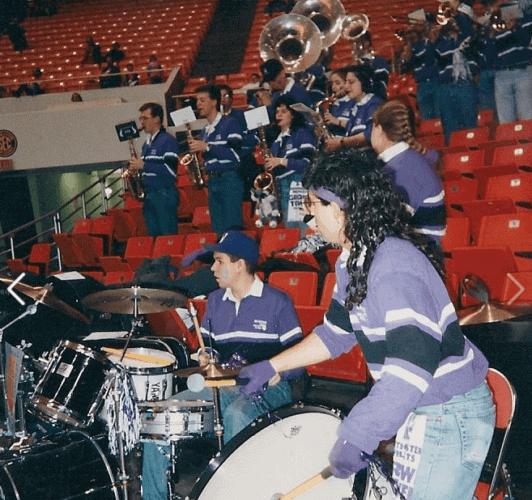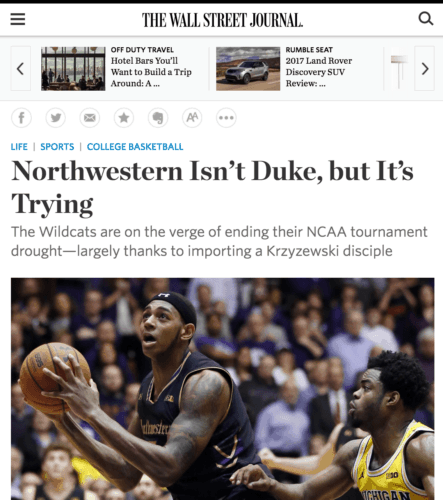Today's Post in <50 Words: While I'm writing here about Northwestern men's basketball learning from Duke (without copying everything), the same ideas apply if you're Ford learning from Toyota or a hospital learning from ThedaCare.
As a proud Northwestern alum and sports fan, I was a bit disappointed that the men's basketball team lost a close game to Purdue yesterday on national television.
I was in the basketball band for four years and saw a lot of Northwestern losses, but it was still fun. That's me, below playing the drum set (in the hat, not with the long hair) at a 1993 women's NCAA tournament loss in a game played at Tennessee (hence the orange seats).

To get further sidetracked, the guy with the long hair playing the bass drum, also named Mark, sings in the vocal group “Face” that appeared on NBC's “The Sing Off” and in an airport video that went viral a few years back. Small world.
Listen to Mark read this post (subscribe to the podcast):
Anyhoo… being a Northwestern basketball fan is tough. They've had some pretty bad teams and they are the ONLY major conference team to NEVER make the NCAA tournament.
Until maybe this year.
It's still scary (fear of disappointment) to see stuff like this on TV.
I will keep saying “maybe” until it gets formally possibly maybe perhaps gets announced next Sunday. I'll have to stay up until midnight, because I'll be in Brussels to teach a class on “better metrics” at the European Lean Healthcare Transformation Summit there.
A few of you sent this Wall St Journal article (thanks!):
Northwestern Isn't Duke, but It's Trying

In 2013, NU (don't call us NW… looking at you, ESPN) hired Chris Collins away from Duke, where he played and had been an assistant. This was his first head coaching job, but he was a proven winner.
But, he had always been in a winning program. Sustaining a winning program is different than building one.
I think of parallels to ThedaCare, who most consider a world leader in Lean healthcare application and results. Leaders including John Toussaint, MD built a program at ThedaCare, just as Coach K did at Duke.
2018 Update: What's Going on at ThedaCare?
I know of at least one ThedaCare leader, Kathryn Correia, who was hired away into a CEO role at another health system, coming from a leadership role at ThedaCare that wasn't quite at the CEO level.
I think Kathryn has been pretty successful at HealthEast. I see her and some of her people at the annual Lean Healthcare Transformation Summit each June (hope to see you there and I'll be repeating that workshop).
I know some other people who were hired away out of lower-level jobs at ThedaCare who have struggled at their new organization (and for reasons that aren't their fault, in my opinion).
Being asked to transform an organization is different than knowing how to play a role in one that's already successful. If you're not hired in as CEO, you're at the mercy of a CEO who maybe isn't very committed to learning about or practicing Lean.
It would be like if Northwestern had, in 2011, hired away a low-level video coordinator from Duke and then expected that person to transform Northwestern basketball under the old head coach who maybe didn't want to change.
When I worked at GM, I learned a lot from my second plant manager, Larry Spiegel, who had learned how to turn around factories with Lean and TPS, starting at NUMMI. I've seen other people come out of Toyota who then floundered at my old company, Honeywell. Working at Toyota didn't mean they knew how to turn Honeywell into Toyota (especially if they weren't at the right level to do so).
I guess if the question is, “If I hire a leader away from another organization I'm trying to emulate, are they going to be successful?” then the answer is probably, “Maybe.”
So anyway, back to Northwestern. From the Journal article:
“Coming from a place like Duke is a perfect example for us in terms of how to build a program,” [Northwestern athletic director Jim] Phillips said. “There's absolutely been a road map by Coach K that Chris has been a part-author of.”
It's interesting to hear the phrase “road map” because many ask for a “Lean road map” for transforming their factory, business, or hospital. It's not always so easy to copy and paste.
The University of Houston has been successful, in football, the past two seasons when they hired a coach out of Ohio State… and he was trying to emulate the Ohio State model without coping everything:
There's the same approach at Northwestern… emulate (and Duke is a very close parallel to Northwestern in many ways) but don't copy exactly.
“Collins is about to change that [history of losing], in large part because he arrived in Evanston with a simple notion: Northwestern might not ever be Duke–but there no reason it can't be like Duke.
“I wanted to mimic the ideals of Duke,” Collins said, “but not try to recreate it.”
They copy some things:
“For sure, aspects of Duke are imprinted on Northwestern. Collins tapped Chris Lauten, a former student manager with the Blue Devils, as his director of basketball operations, choosing him because of his institutional knowledge of how Krzyzewski runs Duke.
As a result, Lauten said the Wildcats model how they “structure, organize and execute a practice” after the Blue Devils. That principle also applies to areas like scouting opponents, film sessions and team meetings.”
This might be a parallel to a leader like Correia hiring some ThedaCare people away who know how to “structure, organize, and execute” a daily department team huddle. There are certain nuts and bolts to running an organization that don't have to be reinvented.
That said, I've been to a few organizations lately that said, basically:
“We visited ThedaCare and copied their huddle boards.”
I guarantee the ThedaCare huddle boards aren't as blank and empty as the boards I've seen recently. One board had just a lonely single employee idea card up there. The O.R. manager said, “We normally just have one idea at a time.”
No they don't. The employees have LOTS of ideas. The manager just isn't engaging them or drawing out those ideas, as they generally do at ThedaCare (and as they do VERY well at Franciscan St. Francis Health — read about that or come visit them).
Here is a new video about this site visit and workshop, by the way:
Copying the board without emulating the leadership style… that's probably not going to work. That was the case in the auto industry 20 years ago and it's the case in healthcare today. When will we learn?
When people come visit Franciscan St. Francis, we all say, “Learn but don't copy.”
See this article from 10 years ago about how Ford copied the Toyota “andon cord” without copying the management system:
I'm not sure why they thought that would work.
Collins and Northwestern aren't copying everything:
“There are differences, of course. Lauten said Collins tends to be more hands-on with his players in practice than Krzyzewski, who at this point often acts more as an overseer who delegates the nuts-and-bolts to his assistants. Considering the burgeoning state of the program, Collins also tends to take a gentler approach than Krzyzewski when his team struggles, assuming the role of teacher more than enforcer.”
This is smart of Collins to adjust his approach. He can't act exactly like Coach K acted in 2012. Collins, as it says in the article, has to be more like Coach K was in 1980, at the start of building the Duke program (and Collins wasn't there at that time, of course).
Just as every leader who left ThedaCare or Toyota hasn't been successful… the same is true for assistant coaches who left Duke to take their first head coaching job:
“Other coaches in the past have left Durham with the intention of bringing Duke elsewhere, with varying degrees of success. Johnny Dawkins made just one NCAA tournament in eight years at Stanford. Tommy Amaker never reached the tournament in six years at Michigan before faring better at Harvard. Duke isn't easy to replicate.“
Coach K gave Collins great advice:
“That's why when Collins took the job at Northwestern, he says the best piece of advice Krzyzewski gave him was, “Don't try to recreate Duke. Don't try to recreate me.”
I've heard ThedaCare people say the same thing:
Wish us luck! I hope Northwestern is this year's “Cinderella story.”
More importantly, I hope your organization becomes a Lean organization. Learn and emulate, but don't copy blindly. I think that's good advice for anyone.
Go ‘Cats!
What do you think? Please scroll down (or click) to post a comment. Or please share the post with your thoughts on LinkedIn – and follow me or connect with me there.
Did you like this post? Make sure you don't miss a post or podcast — Subscribe to get notified about posts via email daily or weekly.
Check out my latest book, The Mistakes That Make Us: Cultivating a Culture of Learning and Innovation:










Couldn’t agree more. One of the central tenets of process improvement is y=f(x). Process improvement leaders inherently understand this within the context of a project, but many don’t see the relevance within the context of the broader enterprise deployment. They copy and paste the “f” from some organization that has successfully built an impactful and sustainable capability without first understanding if their x’s are similar. That cut-and-pasted deployment plan will only give you the same outputs if your inputs (organizational culture, people capabilities, data/technology infrastructure, change readiness, strategic vision, etc) are identical. That’s rarely the case. So we have radically different inputs going through the cut-and-pasted Lean deployment approach, but we’re still surprised when we don’t get the same results.
I thought of this post today, in a way, when I saw this quote:
This reminds me of Dr. Deming’s caution that a sure way to failure is by striving to copy.
Deming said, “They don’t know what to copy!” in reference to those in the West trying to copy Japanese companies.
http://quotes.deming.org/authors/W._Edwards_Deming/quote/10176